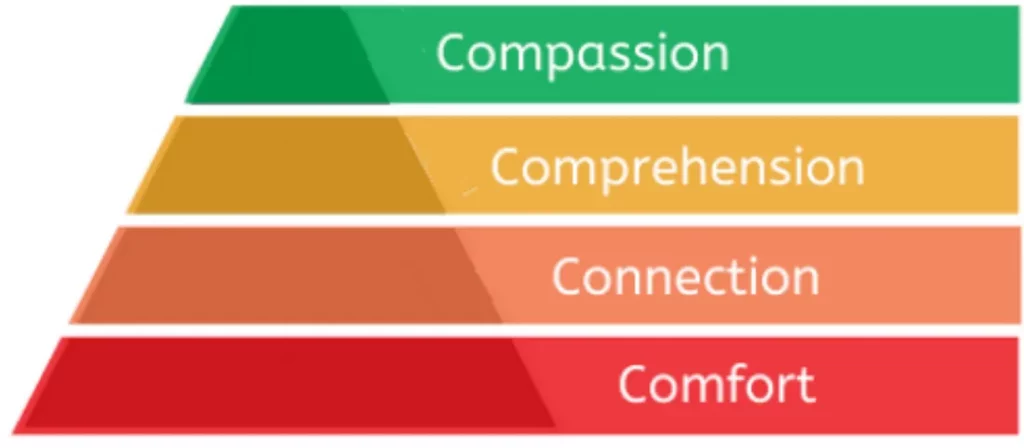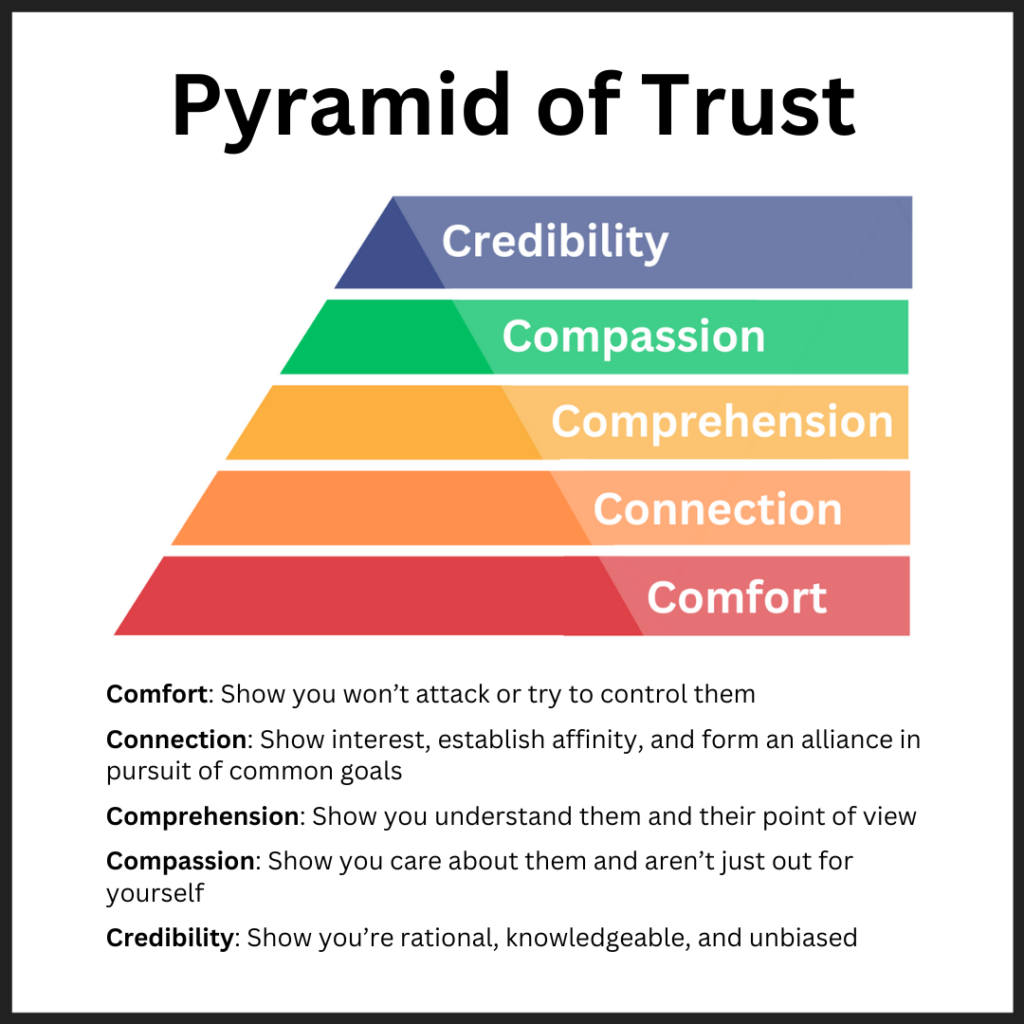Climbing the Trust Pyramid to Create Change

Most conversations about contentious issues go off the rails because folks ignore the psychological barriers to opinion change. The Trust Pyramid (inspired by Abraham Maslow’s hierarchy of needs) shows it takes far more than just facts and reason for most people to revise their attitudes and beliefs.
Credibility is important, but other needs — for comfort, connection, comprehension, and compassion — come first and matter more. To persuade others, guide them from the bottom of the pyramid to the top by focusing more on meeting emotional needs than addressing reasons for change. Here’s how.

1. Comfort
The first step is to make a someone feel safe-enough to have a conversation. No one hears you when they’re worried about being yelled at for their beliefs or called a bad person.
Here are some ways to make them more comfortable:
- Invite them to a conversation (rather than demanding it)
- Tell them you won’t attack them
- Let them know their stance is their choice and you won’t tell them what to do
- Promise not to judge them as a person
- Say you’ll value your relationship with them no matter what
Of course, promising to treat your loved ones with kindness and respect is not enough— you must follow through. If at any point during the dialogue the other person feels too threatened, the conversation will break down and you’ll lose their support.

2. Connection
Creating a safe-enough space isn’t sufficient to swing votes. Someone can feel comfortable talking with you, but still not reconsider their beliefs or listen to what you say. To get them to consider your perspective and reevaluate their views, you need to build a connection based on mutual trust.
Winning someone’s trust in a conversation is surprisingly easy: Just make yourself vulnerable. Same as a dog makes friends by showing its belly, you can quickly connect in a political conversation by taking calculated risks.
Here are some ways to make yourself vulnerable when talking with others:
- Admit you’ve behaved badly in past conversations (yes, you have, you know you have)
- Confess you’re feeling anxious about having this conversation
- Concede that you’ve been wrong on issues in the past
- Reveal your position on a divisive issue and admit you’re worried they’ll think you’re a bad person because of it (e.g., tell someone who has a strong stance on an issue that you have the opposite stance)
The amazing thing is this feels scary, but makes you safer. Not only will the other person trust you — they’ll like you more too.

3. Comprehension
Once you’ve won someone’s trust, you need to understand where they’re coming from. We’re all eager to share our perspective, but most people won’t listen to you until you listen to them first.
Before asking someone to take your side, ask for their thoughts about the issue and pay close attention to their answers. They’ll probably say a lot of things you disagree with or that are untrue. That’s okay. Let them. Don’t interrupt or tell them they’re wrong — right now your goal is to understand what they think, not change it.
Once they’ve said their piece, you’ll want to tell them why they’re wrong. Don’t. Instead, show you were listening.
First, reflect back what they said. A reflection is a summary of the other person’s point of view.
“Mary, it sounds like you feel strongly that…”
If your reflection hits home, they’ll say, “Yes, exactly!” or “I couldn’t have said it better myself.”
Second, agree with what you can. The other person will probably say a whole bunch of stuff you disagree with, but there will be some wheat amid the chaff. Watch for and agree with common emotions, values, and goals.
“Grandma, you know, I’m also really worried about the economy and our quality of life and safety.”
Highlighting areas of agreement (despite differences) reduces defensiveness and creates an alliance. It turns your disagreement into a shared struggle for the future you both want.

4. Compassion
Now that the other person feels comfortable, connected, and understood, it’s time to further strengthen your relationship by offering compassion. Just saying, “I understand” or “I hear you” isn’t enough. Those are nice platitudes, but they don’t convey heartfelt emotion. No one feels cared for because someone says, “I feel your pain.” Instead, show them how their suffering resonates with you.
First, name their emotions. People don’t always say (or know) what they’re feeling, but if you listen closely, you should be able to tell. Show you are hearing their pain by putting feeling words to their emotional state like “angry,” “sad,” “frustrated,” “worried,” and “scared.”
“Auntie, it sounds like you’re really confused by recent events and reports. You feel strongly about them and you’re frustrated that others can’t see that. You’re also furious at some of the extremes some folks are going to.”
Second, tell a story about a time when you felt similarly. If, for example, if they say they don’t support your cause it sounds like it will affect their lifestyle or finances or personal safety, take a deep breath and say something like:
“You know, that reminds me of how I felt a couple years ago when I was dealing with a problem like this in my life, where a change in my community made me feel confused, unsafe, or vulnerable. My personal fears and doubts made it hard to support a larger change around me. Sometimes it can be really hard to balance what we want and what’s good for our community, country, or the world.”

5. Credibility
Finally! You’ve ascended to the top of the Trust Pyramid! You’ve built a base of comfort, trust, understanding, and caring engagement, and now you really want to express your own views.
But be careful. If you make your loved one feel unsafe now — by getting argumentative or shaming them — you can still bring the whole thing crashing down like a game of Jenga. And no matter how polite you are, facts and reason won’t change their mind.
So, what will persuade them?
In conversation, we need to earn the other person’s respect by showing we are rational, unbiased, and knowledgeable:
- Show we’re rational by sharing attitudes and beliefs that are largely within their zone of acceptance.
- Show we’re unbiased by naming common ground, admitting weaknesses of our “own side,” and acknowledging when we are wrong.
- Demonstrate we’re knowledgeable by providing information the other person finds interesting and useful that largely comports with their understanding of the world while simultaneously broadening it.
Change works best when the other person is driving the change—it’s rare for someone to trust another person more than themselves. So, when it comes time to make your case, others need to feel like you are worth listening to.
Unless you’re perceived as an expert on a subject or exceptionally wise, chances are the person you’re talking with thinks they’re an equal or even better than you. Since they won’t automatically defer to you in most cases, you’re better off guiding them to a new perspective rather than telling them what to think.
First, get them to make the case for supporting your issue themselves with a little conversational jujitsu. Ask, “How important do you think it is to address this issue and makes some changes?” and get them to rank their answer on a scale from 0 to 100 where 0 is “not important at all” and 100 is “one of the most important issues we face.” Then, no matter what rank they give, ask “Why not lower?” This will remind them of the things they do support on your side of the issue.
Second, tell them what a change on this issue would mean for you personally. Instead of making some abstract case for why they should support your stance, explain to them exactly what a policy change would mean for you. How would your life change for the better if this issue was addressed or for the worse if it’s not? Here’s an example:
“Jason, as you know, this issue is important to me. I fear that if it’s not addressed and we don’t change our approach, it will directly impact and hurt me and my family and our lives. [Share a specific way in which the issue could negatively affect your life, if changes aren’t made.]”
The big difference is that rather than talking about the issue in general, you’re talking about how it directly affects yourself and your family. In this you way, you provide the strongest possible motivation for them to change their mind: It will help someone they care about.



